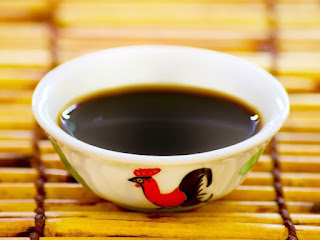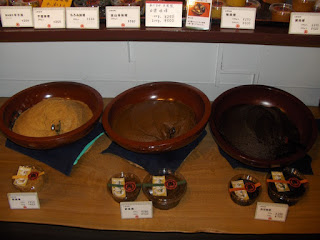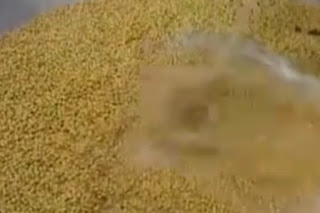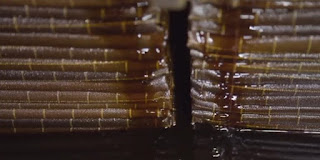 |
| Soy sauce |
History and Origin of Soy Sauce
The origin of soy sauce is rooted in a fermented soybean paste which was used to preserve food and also as a condiment to enhance flavor. Though the earliest records for this soybean paste are found in ancient China, the evolution of the paste to a soy sauce occurred over a period of many years in the neighboring countries of Korea and Japan. |
| Historic countries of China, Korea and Japan |
 |
| Doenjang (soybean paste) |
Influence of Jiang in China on Soy Sauce
The predecessor of the soy sauce originated in ancient China in the form of a fermented paste called 'jiang'. The early reference to this fermented paste can be found in the Han dynasty, listed on the bamboo slips found in the Han Tomb 1 at the Ma-wang-dui archaeological site located near Changsha, China. The word 'jiang' is also found in the silk manuscript discovered in Han Tomb 3. |
| Silk map from Western Han period found in Tomb 3 of Mawangdui |
The creation of jiang was based from the need to preserve food and subsequent discovery through experimentation that when meat, seafood and later soybeans were salted or immersed in a mixture of salt and rice wine or water, their protein was broken down by enzymes into amino acids, which in turn stimulated human taste buds, augmenting the flavors of other foods.
The earliest literature reference to jiang as a fermented soy paste is found in the Chi Chiu Pien, composed in the 2nd half of the first century BCE where it says that soybean and wheat flour are mixed to produce jiang. A more detailed description for the preparation of jiang is found in the Chi Min Yao Shu, a Chinese agricultural encyclopaedia of the 6th century.
Subsequent references of jiang in Chinese literature show the evolution in the preparation of the soy paste. In the 8th century work titled Ssu Shih Tsuan Yao (Important Rules for the Four Seasons) the recipe is simplified and the process of fermentation is more streamlined.
Influence of Doenjang in Korea on Soy Sauce
In Korea the fermented soybean paste known as 'doenjang' and the fermented soy sauce as 'kanjang' have been in use for over 2000 years and are an integral part of the Korean cuisine.It is generally recognized that Korea played an important role in the early experimentation of soybean fermentation and subsequent production of the soy sauce. The traditional fermentation techniques in Korea were known to be far advanced and a major influence in the early production of the soy sauce.
 |
| 1340 edition Jijiupian, National Diet Library |
In the history book of Wei, the Chinese dynasty that existed during the period of the Three Kingdoms in the 3rd century, the fermentation techniques of the Korean people are acknowledged and praised.
Influence of Miso in Japan on Soy Sauce
Miso in Japan refers to a fermented soybean paste which influenced the creation of the Japanese soy sauce. Before the miso, the Japanese people are known to have developed condiments by pickling salted fish and meat called hishio. |
| Miso paste |
A reference to the miso can be found in the Wamyō ruijushō , the oldest existing Japanese dictionary from the 10th century, which states that miso is produced in the countryside.
During the Kamakura period (1185–1333) miso became a staple in the Japanese diet. It was during the Kamakura period in the 13th century, that a Zen monk, in the town of Yuasa, is said to have noticed, that the liquid collected in the barrels of the miso paste as a by-product had a flavorful taste, and so the Japanese soy sauce was born.
By the middle of the 17th century the process of producing soy sauce in Japan had been established and began to spread throughout the country to keep up to the demand for this flavorful sauce.
The Art of Making Soy Sauce
The production of natural soy sauce is an ancient art which has been refined over the centuries. Today, most of the natural soy sauce found in stores is produced by automated processes, yet the fundamental brewing and fermentation process has not changed over the centuries. |
| Soy sauce |
The Five Main Ingredients
The five main ingredients for making soy sauce are soybeans, wheat, water, salt and mold.Soybeans : The unique characteristics of soy sauce comes from the proteins contained in the soybeans.
Wheat : The starch in the wheat gives soy sauce its sweetness and imparts a soft more balanced flavor to it.
Salt and Water : The combination of salt and water called the brine acts as a preservation, by suppressing the destructive organisms and decay causing bacteria during the fermentation process.
Mold : Used to ferment the soybeans and wheat. The scientific name for it is Aspergillus oryzae.
The Soy Sauce Production Process
The process is started by pouring the soybeans in a vessel called steam kettle. After rinsing the soybeans, the kettle is filled with water, the soybeans are soaked and then steamed at a high temperature. The soybeans are then taken out of the kettle and spread out in large trays to cool. |
| Soybeans soaked in water |
The crushed wheat is then mixed with the soybeans, and the mold is added to the mixture. The trays containing the mixture are then moved to a temperature controlled incubation room to activate the mold.
 |
| Mixture of soybeans, wheat and mold |
The fermentation process lasts between 6 to 12 months for most commercially produced soy sauce, during which the mixture is repeatedly stirred. Some producers may use a longer fermentation period to create a more richer flavor.
 |
| Soy sauce extraction by pressing |
The raw soy sauce is then clarified and heated to halt the activity of the enzymes and stabilize the quality of the soy sauce.
The Rich Complex Flavors of Soy Sauce
The flavor, aroma and color of soy sauce is generated by the fusion of the soybeans, wheat and salt that are the main raw materials. The flavor is a balanced composition of sweetness, acidity, saltiness, and bitterness derived from the optimum blend of ingredients, using the ancient fermentation process. |
| Soy sauce |
References
Fermentations and Food Science by H. T. HuangApplied Mycology and Biotechnology Volume 2 Agriculture and Food Production Edited by George G. Khachatourians and Dilip K. Arora
Article Category: Food History




No comments